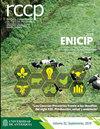Presence of Chlamydia abortus in colostrum, milk and vaginal discharge samples of sheep
IF 0.5
4区 农林科学
Q4 AGRICULTURE, DAIRY & ANIMAL SCIENCE
引用次数: 0
Abstract
32 Background: The main route of transmission of Chlamydia abortus is the ingestion of 33 the microorganism that has been eliminated in vaginal secretions, placental membranes 34 or abortions that contaminate the environment, and possibly through milk and colostrum. Elimination through vaginal secretions is well documented. However, there are no reports of the isolation and identification of C. abortus in the colostrum or milk of infected sheep, so it is important to determine whether or not the bacteria may be present in these secretions, which are the only food of lambs. Objective: Detect the presence of C. abortus in colostrum, milk and vaginal secretions of sheep with a history of reproductive 40 disorders. Methods: In order to isolate and identify C. abortus in these secretions, 41 colostrum, milk and vaginal exudate were collected from 66 sheep. The samples were 42 inoculated in mouse fibroblast cell cultures and the presence of the bacteria determined 43 by direct immunofluorescence. Results: 19 of 66 colostrum samples (28.7%), 14 of 66 44 milk samples (21.2%) and 17 of 66 vaginal swabs (25.7%) being positive. The 50 samples 45 positive for isolation and detected by immunofluorescence, together with 42 negative 46 ones, were subjected to qPCR to amplify a fragment of the omp A gene from C. abortus . 47 Thirty-eight of the 92 samples processed by this technique were positive for C. abortus . 48 Conclusion: The results of the present study demonstrated the presence of C. abortus in 49 a high proportion in colostrum, milk and vaginal secretions of infected sheep. This work 50 is the first field study in the scientific literature confirming the presence of C. abortus in 51 colostrum, which shows that the excretion of Chlamydia by lactogenesis could occur in 52 the first hours after birth. 53绵羊初乳、乳汁和阴道分泌物样本中存在流产衣原体
背景:流产衣原体的主要传播途径是摄入阴道分泌物、胎盘膜或污染环境的流产中已被消除的微生物,也可能通过牛奶和初乳传播。经阴道分泌物消除是有充分证据的。然而,在受感染羊的初乳或乳汁中没有分离和鉴定产弧菌的报道,因此确定细菌是否存在于这些分泌物中是很重要的,因为这些分泌物是羔羊的唯一食物。目的:检测有生殖障碍绵羊初乳、乳汁及阴道分泌物中流产梭菌的存在。方法:从66只羊的初乳、乳汁和阴道渗出液中分离鉴定产弧菌。42份样品接种于小鼠成纤维细胞培养物中,43份样品采用直接免疫荧光法检测细菌的存在。结果:66份初乳标本中阳性19份(28.7%),66份乳标本中阳性14份(21.2%),66份阴道拭子标本中阳性17份(25.7%)。采用qPCR方法,对50份分离阳性和免疫荧光检测的样品(45份)和42份阴性样品(46份)进行扩增。92份样品中有38份产弧菌阳性。结论:本研究的结果表明,在感染羊的初乳、乳汁和阴道分泌物中,流产梭菌的比例很高。这项工作是科学文献中首次证实在初乳中存在C. abortus的实地研究,这表明衣原体可能在出生后的最初几个小时内通过乳发生排出。53
本文章由计算机程序翻译,如有差异,请以英文原文为准。
求助全文
约1分钟内获得全文
求助全文
来源期刊

Revista Colombiana De Ciencias Pecuarias
AGRICULTURE, DAIRY & ANIMAL SCIENCE-
CiteScore
0.80
自引率
0.00%
发文量
18
审稿时长
6-12 weeks
期刊介绍:
The editors of Revista Colombiana de Ciencias Pecuarias (RCCP) welcome the submission of original manuscripts on experimental and clinical studies associated with the broad areas of animal sciences and veterinary medicine as they interface with biochemistry, molecular biology, physiology, pharmacology, toxicology, pathology, microbiology, parasitology, immunology and epidemiology. The scope of the journal includes studies of basic and applied research in animal management and production, feeding and nutrition, reproduction, breeding, genetics, animal welfare and behavior; as well as animal production focussed from biotechnology, soil science, agrostology, silvopastoral systems, livestock economics and the environment.
The criteria for acceptance of papers submitted for publication are originality, quality and clarity of the content. Each contribution must be based on original, unpublished research that has not been simultaneously submitted to other journals. All papers will be peer reviewed. All authors bear responsibility for ensuring the integrity and quality of their reported research. It is the author''s responsibility to secure permission to use figures or tables that have been published elsewhere.
Contributions may be classified as original research, review, rapid communication, clinical case studies or methodological articles, as well as news/commentaries or letters to the editor. Most review articles are invited by the editor. Authors interested in submitting a review article should contact the corresponding editor. Rapid publication of original manuscripts is a goal of the journal. Manuscripts must be written in English. Each manuscript is considered for publication with the understanding that it has not been simultaneously submitted to any other journal. Upon acceptance for publication, papers are subject to editorial review and revision.
 求助内容:
求助内容: 应助结果提醒方式:
应助结果提醒方式:


